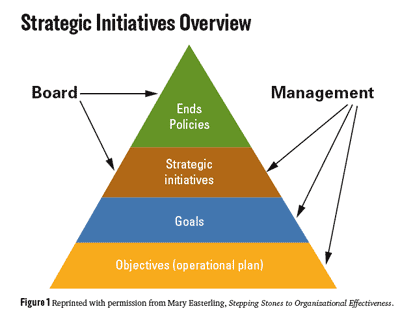Policy Governance: A New Look

This article contains charts that are not pictured here. You can download a pdf of the article here
In support of cooperatives helping other cooperatives, the board of directors at Outpost Natural Foods (Milwaukee, Wis.) has committed to more community involvement and better connections with other cooperative boards. One way cooperative boards can help one another is by sharing ideas and experience in hopes of elevating the quality of governance in the cooperative system. In that spirit, I would like to share a case study on how the Outpost board is addressing some of the tougher governance issues that boards face.
The Carver model of Policy Governance has been adopted by many boards in the cooperative community. At Outpost, we have been using it in various iterations for roughly six years. Perhaps our journey has been similar to yours, or perhaps your co-op is just starting the journey and trying to avoid some mistakes that have already been made by your peers. Regardless, the Outpost board is doing some new things to address the toughest issues of the model. These issues include:
- Ambitious ends statements that address “at what cost”;
- Rigorous monitoring of high-level, non-prescriptive limitations policies; and
- Board process and monitoring that clearly demonstrate meeting the board’s fiduciary obligations.
This paper discusses how our board is confronting these issues and provides examples of our implementation to date.
Ends: using strategic initiatives to address the cost
Who gets what? Like many ends statements from other cooperatives, Outpost’s original ends statement was a “community” defined by various means. For example, we had statements that attempted to define our end “community” by the following: flourishing cooperative commerce; sustainable practices; individual well-being for community members; and honesty and integrity in all relationships.
Although lofty ideals, these were not ends statements, but means statements. For the model to work, ends statements have to deal with ends issues. The Carver Guide—Basics of Policy Governance states that “only those issues that address what benefit, which recipients beyond staff…” (p. 13) are ends issues. In working terminology: our cooperative exists, so who gets what?
Time devoted by our board to these important ends issues has helped us arrive at statements that are truly ends rather than means, which keeps the board out of the operations domain in accordance with the model. As an example, one of our ends statements now reads:
The cooperative infrastructure is supported. [who (the cooperative infrastructure) gets what (supported).]
So, rather than stating that our end community is defined by the means of flourishing cooperative commerce, we are stating that our organization exists, in part, so that cooperative infrastructure is supported.
At what cost? The “cost” portion of ends is one issue our board had successfully avoided since initial implementation of the model. We did state that the cost of ends should not jeopardize the long-term strength of the cooperative. But setting a direction in terms of cost is much more than limiting damage—and it is of particular importance to the use of the model for cooperatives.
Because of the cooperative values and principles, cooperative ends statements generally leave the general manager with a multitude of possible priorities: developing healthy and sustainable communities, access to organic or local products, local community development, education, cooperative economic development, and others. How to prioritize these various ends is a “cost” issue. We know we can’t do it all at once, and we know that different ends require more attention, depending on the situational factors that are affecting the cooperative at any given point in time. “At what cost” is a decision that can’t be made solely by the board or the general manager; both must have a place in this discussion.
Our board has tackled this issue through the use of strategic initiatives. The strategic initiative process involves the board and general manager working together on the prioritization of ends annually through high-level plans. Strategic initiatives are where the board and general manager’s work come together—as shown in the pyramid at right. The strategic initiatives are where the board speaks to the cost issue of ends in greater detail and where the general manager solidifies her/his interpretation of the ends statements and begins the planning of operational goals and objectives for the organization that will ultimately demonstrate progress towards ends. Of course, just like the ends statements themselves, strategic initiatives should be informed by linkage with the owners.
At our board meetings, we often focus on “envisioning the future.” These discussions of various end-related ideas often become translated into strategic initiatives. For example, our ends statements include “owners having a diverse community” and “owners having a sense of belonging.” Our board has spent a significant amount of time this past year discussing what it means for our cooperative to be a diverse community and what a diverse community does to cultivate a sense of belonging. One conclusion from these visioning conversations has been that our staff needs to be (more) diverse. Therefore, we established a strategic initiative with our general manager this year to “implement initiatives that will diversify the staff at all levels of the organization.”
This is neither an ends statement nor an operational goal or objective. The initiative itself is open to plenty of interpretation, but also is specific enough to hold the general manager accountable for its accomplishment. The strategic initiative also allows the board and management to agree on priorities (i.e., cost) for ends progress for the year.
The board acknowledges that this the utilization of strategic initiatives is a deviation from the ends/means distinction advocated by the Carver model, but is hopeful that this interpretation helps in better addressing the cost piece of ends and ultimately in governing our organization more effectively. Boards should realize that the use of strategic initiatives does blur the line in terms of accountability, given that the statements are co-owned by the board and the general manager.
As an aside, the specific nature of the initiatives allows for a very clear way both to evaluate the general manager at the end of the governance cycle and to establish performance-based pay (i.e., bonus) plans for the executive.
Executive limitations: six principles
We have learned much about limitations. In the evolution of our policy register, I think we hit 50 pages! In our best of intentions to codify all that we had learned and all that we thought was important, we simply used the Carver semantics to prescribe to our general manager how she should operate the cooperative.
One policy in our Relationship to Owners limitation reads as follows: The General Manager may not fail to ensure accurate and current Owner records, including name, address, equity payments and eligibility for benefits and voting. This was further defined by four additional policies.
But this was not a limitation policy. It did not say that the general manager cannot do something. Instead, it used language of limitation to prescribe what the general manager should do. We realized that with prescriptive limitations policies such as these, we were inserting ourselves into the operations and thereby losing some of the benefit of the policy governance model. To change this practice, the board had to willingly release its work of years of policy development.
In our efforts to reduce the volume of policies and truly use the model to limit, we spent an entire retreat looking at these prescriptions to identify what our concerns really were. All of the policies boiled down to six limiting principles: integrity, legality, mutual respect, sustainability, growth, and accessibility. We now have one limitation policy that speaks to these central principles of our limitations. The job of the board now is in monitoring these limitations. And since there are fewer policies to monitor, we can now monitor at a much deeper level.
Better board oversight
The Carver model calls for three types of monitoring: internal report, external report, and direct inspection. General practice suggests that the majority of monitoring comes from an internal report from the general manager.
Fiduciary obligations for the board of directors varies by state, but most states have a “duty of care.” Legal guidance in meeting this duty of care calls for board verification of information provided by management. With most monitoring information coming directly from the general manager in the Carver model, our board became concerned that we were not meeting our fiduciary obligations. How were we verifying information?
Our solution was to explore more external and direct monitoring to provide context, verification, and a reasonableness check of the internal reports provided by management. The general manager still interprets the policy, but the external and direct inspection reports provide information to the board in deciding whether the general manager’s interpretation and conclusions are reasonable. Then we can make an annual assessment, based upon all monitoring evidence gathered, of whether the general manager was operating within the limitations established by the board. On page 41 is our plan for monitoring (note that the internal reports from the general manager are in bold and are followed by the external or direct inspection reports used to provide the board with data to make decisions about those reports).
In planning our monitoring, we made efforts to ensure that we had at least three external or direct monitoring sources for each limitation area that could be corroborated with the internal reports we receive from the general manager. Should the board ever come under scrutiny in a particular area of these limitations, we have very clear monitoring evidence that we were fulfilling our duty of care to the ownership.
Board process: fiduciary obligations
Board process policies define the board’s work. Our board has taken the position that our job is to lead the organization in response to fiduciary obligations to the ownership of the cooperative. The fiduciary obligations (in the state of Wisconsin) are duties of care, loyalty, and obedience. In our case, we took the obligations and the corresponding legal precedents and incorporated many of these items into our policy register to help guide our own board process.
As with our limitations policies, our policy register had grown exponentially, resulting in pages and pages of prescriptive board process policies. Boiling down these prescriptions to their fulfill- ment of fiduciary duties of care, loyalty, and obedience, we were able to create a list of monitoring methods that demonstrated that fiduciary duties were being met.
See page 42 for our table of Board Fiduciary Obligations.
Conclusions
The evolution of this work has reminded our board of the power that exists in the Policy Governance model to govern our organization well. We have found what is making the model work for us is our shift from cursory monitoring of our unwieldy, overly prescriptive limitations policies to rigorous monitoring focusing on our fiduciary obligations, combined with owner linkage to help set strategic initiatives that guide the organization towards its ends. This is a work-in-process that will continue to evolve. Being open to that evolution and learning is something that makes our board, and the cooperative sector as a whole, a great place to be a leader!
***
Heather Schmidt Albinger is president of the board of Outpost Natural Foods. She is a CPA and an assistant professor of business at Concordia University Wisconsin (heather.albinger@cuw.edu).







